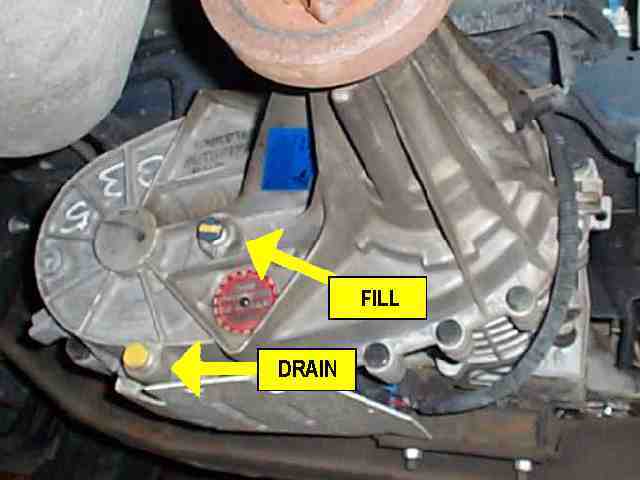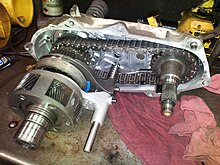
Into every life, a little fuck-up must occur.What I thought was an easily resolved leak at the drain plug on the transfer case under the RV, turns out to be cracked case. Perfect. There was a thought of making a fix with a product called JB Weld, it's an epoxy..and it might have worked, but..it might have failed at an inopportune moment. I am about to put on some pretty serious miles and some of that will be off-road in the deserts of Nevada and California. The shop guy suggested I contact a local wrecking yard and yes, they had one..so, this morning, that is being swapped out. It's a fairly time consuming, dicking around thing. I am hoping to be out the door early afternoon tho.

I thought that maybe there would be someone that didn't understand what a transfer case does....like myself, for instance.
Transfer case
From Wikipedia, the free encyclopedia
A transfer case is a part of a four-wheel-drive system found in four-wheel-drive and all-wheel-drive vehicles. The transfer case is connected to the transmission and also to the front and rear axles by means of drive shafts. It is also referred to as a "transfer gearcase", "transfer gearbox","transfer box", "jockey box", or simply "T-case".Functions
- The transfer case receives power from the transmission and sends it to both the front and rear axles. This can be done with a set of gears, but the majority of transfer cases manufactured today are chain driven.[1] On some vehicles, such as four-wheel-drive trucks or vehicles intended for off-road use, this feature is controlled by the driver. The driver can put the transfer case into either "two-wheel-drive" or "four-wheel-drive" mode. This is sometimes accomplished by means of a shifter, similar to that in a manual transmission. On some vehicles this may be electronically operated by a switch instead. Some vehicles, such as all-wheel-drive sports cars, have transfer cases that are not selectable. Such a transfer case is permanently "locked" into all-wheel-drive mode.
- An on-road transfer case synchronizes the difference between the rotation of the front and rear wheels,[2] in much the same way the differential acts on a given axle. This is necessary, because the front and rear tires never turn at the same speed when front and rear tire sizes differ.
- Transfer cases designed for off-road use can mechanically lock the front and rear axles when needed[3] (e.g. when one of the axles is on a slippery surfaces or stuck in mud, whereas the other has better traction). This is the equivalent to the differential lock.
- The transfer case may contain one or more sets of low range gears (generally for off-road vehicles). Low range gears are engaged with a shifter or electronic switch. On many transfer cases, this shifter is the same as the one that selects 2WD or 4WD operation. Low range gears slow down the vehicle and increase the torque available at the axles. Low-range gears are used during slow-speed or extreme off road maneuvers, such as rockcrawling, or when pulling a heavy load. This feature is often absent on all-wheel-drive cars. Some very large vehicles, such as heavy equipment or military trucks, have more than one low-range gear. In the late 1970s, Mitsubishi installed a transfer case to its front wheel drive products, without equipping a second driveshaft to the rear wheels. It was called Super Shift, and allowed drivers to select from four gears in the "Power" range, utilizing the torque from the engine, and four gears in the "Economy" range, providing better fuel economy at higher speeds.
Types
Those used on "part-time four-wheel-drive" system off-road vehicles such as trucks, truggies, rock-crawling vehicles, and some military vehicles generally allow the driver to select 2WD versus 4WD as well as high versus low gear ranges. Those used in sports cars are usually "transparent" to the driver; there is no shifter or select lever.Drive type
Gear-driven
There are two different types of "internal workings" found in most transfer cases. Gear-driven transfer cases can use sets of gears to drive either the front or both the front and rear driveshafts. These are generally strong, heavy units that are used in large trucks, but there are currently several gear drive cases in production for passenger cars.[citation needed]Chain-driven
Chain-driven transfer cases use a chain to drive most often only one axle, but can drive both axles. Chain-driven transfer cases are quieter and lighter than gear-driven ones. They are used in vehicles such as compact trucks, full size trucks, Jeeps and SUVs. Some off-road driving enthusiasts modify their vehicles to use gear-driven transfer cases, accepting the additional weight and noise to gain the extra strength they generally provide.Housing type
Married
Transfer cases are also classified as either "divorced"/"independent" or "married". "Married" transfer cases are bolted directly to the transmission. Sometimes a "married" transfer case is an integral part of the transmission and the two components share the same housing, as is commonly found on recent Subaru products and some other four-wheel-drive cars.Divorced/independent
An "independent" Transfer case is completely separate from the transmission; it is bolted to the transmission output shaft and a short driveshaft travels from the transfer case to the front and rear differentials. Independent transfer cases are used on very long wheelbase vehicles, such as commercial trucks or military trucks.Transfer case shift type
M.S.O.F.
Manual Shift On-the-Fly transfer cases have a selector lever on the driver's side floor transmission hump and may also have either two sealed automatic front axle locking hubs or two manual front axle hub selectors of "LOCK" and "UNLOCK" or "FREE". To engage the four-wheel-drive system the vehicle must be moving at a lower speeds, the speed at which 4x4 can be engaged depends on the vehicle. This is only for the four-wheel-drive high setting. To engage the four-wheel-drive low setting, the vehicle must be stopped and the transmission must be shifted to neutral, then the four-wheel-drive low can be selected.E.S.O.F.
Electronic Shift On-the-Fly (ESOF) transfer cases have a dash-mounted selector switch or buttons with front sealed automatic locking axle hubs or drive flanges. Some models also have what is called selec trac, which has a slider switch on the center console. Unlike the manual transfer case, this system has a transfer case motor. To engage the four-wheel-drive system the vehicle must be moving at a lower speeds, the speed at which 4x4 can be engaged depends on the vehicle. This is only for the four-wheel-drive high setting. To engage the four-wheel-drive low setting, the vehicle must be stopped and the transmission must be shifted to neutral, then the four-wheel-drive low can be selected..Maya and I were out doing some stuff.....
Transfer case got swapped....apparently now everything is all peachy.


No comments:
Post a Comment